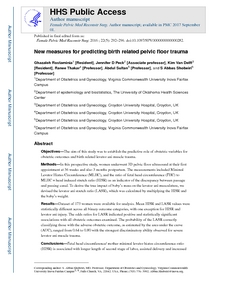Rostaminia, G; Peck, JD; Van Delft, K; Thakar, R; Sultan, A; Shobeiri, SA
(2016)
New Measures for Predicting Birth-Related Pelvic Floor Trauma.
Female Pelvic Med Reconstr Surg, 22 (5).
pp. 292-296.
ISSN 2154-4212
https://doi.org/10.1097/SPV.0000000000000282
SGUL Authors: Sultan, Abdul Hameed
![[img]](https://openaccess.sgul.ac.uk/109559/1.hassmallThumbnailVersion/nihms762036.pdf)  Preview |
|
PDF
Accepted Version
Available under License ["licenses_description_publisher" not defined].
Download (544kB)
| Preview
|
Abstract
OBJECTIVES: The aim of this study was to establish the predictive role of obstetric variables for obstetric outcomes and birth related levator ani muscle (LAM) trauma. METHODS: In this prospective study, women underwent 3-dimensional pelvic floor ultrasound at their first appointment at 36 weeks and also 3 months postpartum. The measurements included minimal levator hiatus circumference (MLHC) and the ratio of fetal head circumference to MLHC = head-induced stretch ratio (HISR) as an indicator of the discrepancy between passage and passing canal. To derive the true impact of baby's mass on the levator ani musculature, we devised the levator ani stretch ratio (LASR), which was calculated by multiplying the HISR and the baby's weight. RESULTS: Data set of 173 women was available for analysis. Mean HISR and LASR values were statistically different across all binary outcome categories, with 1 exception for HISR and levator ani injury. The odds ratios for LASR indicated positive and statistically significant associations with all obstetric outcomes examined. The probability of the LASR correctly classifying those with the adverse obstetric outcome, as estimated by the area under the curve, ranged from 0.64 to 0.80 with the strongest discriminatory ability observed for severe LAM trauma. CONCLUSIONS: Fetal head circumference/mother MLHC ratio (HISR) is associated with longer length of second stage of labor, assisted delivery, and increased severity of perineal trauma. Similar associations were observed for LASR, but in addition, LASR had good discriminatory ability to identify severe LAM trauma.
| Item Type: |
Article
|
| Additional Information: |
This is a non-final version of an article published in final form in Rostaminia, G; Peck, JD; Van Delft, K; Thakar, R; Sultan, A; Shobeiri, SA (2016) New Measures for Predicting Birth-Related Pelvic Floor Trauma. Female Pelvic Med Reconstr Surg, 22 (5). pp. 292-296. |
| Keywords: |
Adult, Delivery, Obstetric, Female, Humans, Labor Stage, Second, Obstetric Labor Complications, Pelvic Floor, Pelvic Floor Disorders, Perineum, Predictive Value of Tests, Pregnancy, Prospective Studies, Ultrasonography, Prenatal |
| SGUL Research Institute / Research Centre: |
Academic Structure > Institute of Medical & Biomedical Education (IMBE) |
| Journal or Publication Title: |
Female Pelvic Med Reconstr Surg |
| ISSN: |
2154-4212 |
| Language: |
eng |
| Dates: |
| Date | Event |
|---|
| September 2016 | Published |
|
| Publisher License: |
Publisher's own licence |
| Projects: |
| Project ID | Funder | Funder ID |
|---|
| U54 GM104938 | NIGMS NIH HHS | UNSPECIFIED |
|
| PubMed ID: |
27054796 |
 |
Go to PubMed abstract |
| URI: |
https://openaccess.sgul.ac.uk/id/eprint/109559 |
| Publisher's version: |
https://doi.org/10.1097/SPV.0000000000000282 |
Statistics
Item downloaded times since 19 Jan 2018.
Actions (login required)
 |
Edit Item |



